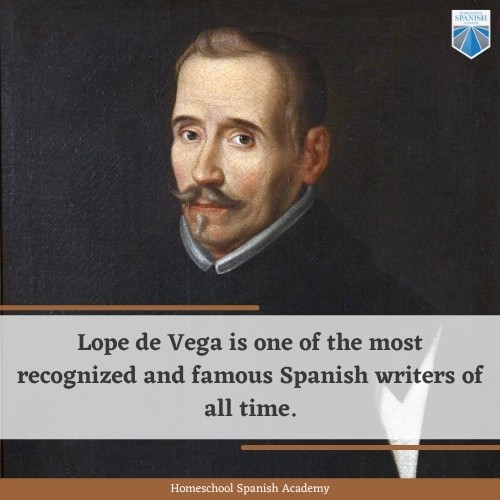
Biography of Spanish Playwright and Poet Lope de Vega
Lope de Vega is one of the most recognized and famous Spanish writers of all time. Cervantes might be the only other Spanish writer who has upstaged Lope de Vega, and that’s no small feat.
Lope de Vega was a well-known poet, playwright, dramatist, and novelist. He wrote several works of art in the 17th century that people still love today.
In his famous essay, Arte Nuevo de Hacer Comedias en este Tiempo (1609), Lope begins by showing how well aware he is of the established rules of poetry and continues to apologize for his inability to follow such rules. He considered himself to be a vulgar Spaniard who spoke the language of fools. Lope de Vega was a superb writer who freely wrote what he felt was needed and not what was expected of him.
Read this article to learn why Lope de Vega is one of the most famous writers in the history of Spain.
Early Life
Lope de Vega was born in Madrid in 1562 to an undistinguished family. He showed great potential at a young age and spoke Spanish and Latin fluently. Even as a child, he could easily translate from one language to the other.
At age 12, he wrote his first play. When Lope de Vega was a teenager, he enrolled in a Catholic school and was noticed by a priest who saw his talents and encouraged him to enroll at the University of Alcala. When Lope de Vega was in University, he thought of becoming a priest but decided it wasn’t for him.
Exile
Lope de Vega fell in love with Elena Osorio, but she left him for another man. He was exiled for eight years because of it. He later wrote La Dorotea inspired by her.
He then signed up for a tour of duty with the Spanish Navy and got married during that time. He was assigned to serve and was called to duty in the Spanish Armada, and his ship was one of the few that returned from a disastrous escapade for the Spanish Army.
Lope de Vega then lived in Valencia for a few years when he returned from his exile and restarted his literary career. He then headed to Toledo for a job as the secretary to the Duke of Alba. During this time, he wrote several sonnets and went on to pen some of his best work of the 1600s.
Once the decade was over, he suffered another tragedy. In 1612, his son, Carlos Félix, died and his second wife died during childbirth. Lope de Vega then decided to gather his remaining children and devote himself to Christianity. His writing was heavily influenced by religion and he joined the priesthood in 1614.
Lope de Vega had a poet son who unfortunately died in 1635 in a shipwreck off the coast of Venezuela, which led to the kidnapping and abandonment of his youngest daughter, Antonia. Lope de Vega was again stricken with deep grief. He died in Madrid on August 27, 1636.
Poetry
Lope de Vega’s nondramatic work was published in Spain under the title Obras Sueltas between 1776 and 1779. Some of his most famous poetry includes
- La Arcadia (1598), a pastoral romance
- La Dragontea (1598), a history in verse of Sir Francis Drake’s expedition and death
- El Isidro (1599), a narrative of the life of St. Isidro, the patron of Madrid
- La Hermosura de Angélica (1602), a continuation of Ariosto’s Orlando Furioso.
Even though he’s known mainly as a playwright, Lope de Vega is also considered one of the greatest poets of his time, along with Luis de Góngora and Francisco de Quevedo.
In the 1580s and 90s, Lope de Vega wrote sentimental poems rich in pastoral themes that were popular mainly because (using several pseudonyms), he wrote about his personal experiences and affairs. This made his poems real and relatable.
His love sonnets, La Hermosura de Angelica and Rimas, are some of his best work. His religious poems were collected in a book entitled Rimas Sacras, which became a bestseller at the time.
In 1634, Vega published a third book of short poems called Rimas humanas y divinas del licenciado Tomé de Burguillos, which he’d written in 1624. It is considered his masterpiece and one of the most valiant and unique volumes of poetry of the 17th century. In Rimas Humanas, Vega assumes the identity of Tomé de Burguillos, a poor scholar whose deep romantic passions for Juana are in conflict with his outlook on life.

Plays
His dramatic writings are ultimately Lope de Vega’s greatest masterpieces; they’ve given him a prominent place in literary history. It’s ironic since he treated playwriting as one of the humblest trades. He claimed that he wrote his plays purely out of financial need and not to be seen as works of high art. In spite of his humility, it’s an undisputed fact that his Spanish drama owes him recognition, especially his famous three-act comedia.
Lope de Vega was categorized as an informal writer of the Siglo de Oro (Golden Age). He believed that a writer’s business is to make himself understood and considered himself to be a defender of ordinary life.
Ironically, the most common criticism of Lope de Vega’s plays today is the complexity of the language used. Despite his desire to write in the language of ordinary people, Vega was a well-educated and intellectually elite writer. His writing reflects the elevated and overwrought style of the Siglo de Oro.
Even though the records vary a bit, Lope de Vega had written as many as 230 three-act plays by 1604. And by 1632, he had written up to 1,500. Throughout his life, he kept writing. Most pieces were printed during Lope’s lifetime, but some manuscripts were bought from actors or had unpublished comedies written by other people. Those are not considered as part of his authentic collection.
Legacy
Lope de Vega is considered to be responsible for reforming Spanish drama. Before him, Spanish plays were highly irregular. Vega used a loose and unregulated style of poetry but expanded literary power in an extraordinary way.
He included stories from the Bible, ancient mythology, saint stories, ancient history, Spanish history, and legends from the Middle Ages and current events. This is precisely why he left a mark on Spanish literature.
The characters he wrote about reflected real people and would carry on to influence many generations of Spanish drama. Here’s a list of all his work.
His legacy persists even though he faced so many obstacles. Lope de Vega lives on through his work and will forever be known as one of the best dramatists of all time.
Share Your Thoughts!
I hope the fascinating story of this powerful Spanish writer has inspired you. What amazed me the most was how resilient he was in facing adversity. Even though he had to surpass a great deal of tragedy and heartbreak, he was still able to write powerful stories that people continue to read, perform, and appreciate today. Had you heard of Lope de Vega? How did his story impact you? Are you interested in reading any of his work? Leave me a comment below and let me know what you think!

Do you love Spanish culture? Check out our latest posts!
- The Best Spanish Learning Podcasts for Kids
- 12 Contemporary Spanish Female Artists Who Will Empower You
- The History and Significance of Guatemalan Jade
- Are Bilingual Children More Likely to Experience a Speech or Language Delay?
- Top 10 Places to Visit in Guatemala City, Guatemala
- Learn About Hispanic History: Were Hispanics Slaves?
- Celebrating Culture and Joy: The Magic of Carnival in Spanish-Speaking Countries
- 15 Mouth-Watering National Dishes of Latin America
- Top 20 Guatemalan Words and Slang Expressions You Should Know - January 2, 2025
- How to Immerse Yourself in Spanish While at Home - December 12, 2024
- 13 Famous Hispanic Women in History Who Made Enormous Impact - January 23, 2023




